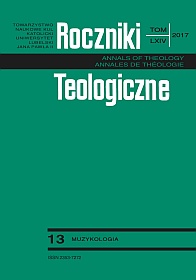Lejtmotyw Miłosierdzia Bożego w kulturze muzycznej od średniowiecza do współczesności
Abstrakt
Lejtmotyw miłosierdzia Bożego jest obecny w kulturze muzycznej wszystkich epok, od czasów średniowiecza, gdzie był obecny w śpiewach gregoriańskich, aż po czasy współczesne. Fundamentem śpiewów, powstałych na przestrzeni wieków, były najczęściej teksty biblijne sławiące tajemnicę miłosierdzia Bożego i Bożej łaskawości. Sposób wyrażenia lejtmotywu miłosierdzia Bożego zależał od zespolenia warstwy tekstu ze współczynnikami muzycznego stylu danej epoki, a także od duchowości i oblicza mistyki danej epoki.
Obecnie jesteśmy świadkami powstania wielu kompozycji zawierających lejtmotyw miłosierdzia Bożego. Ma to związek z intensywnie rozwijającym się w ostatnich latach – zwłaszcza za pontyfikatu św. Jana Pawła II – kultem miłosierdzia Bożego. Impulsem rozwoju kultu były objawienia dane św. Siostrze Faustynie w latach trzydziestych XX w., a zapisane w jej „Dzienniczku”. W konsekwencji fundamentem treści współczesnych kompozycji związanych z kultem miłosierdzia Bożego są przede wszystkim słowa wyjęte z „Dzienniczka” Siostry Faustyny.
Bibliografia
Bramorski J., Teologia muzyki według Księgi Psalmów, „Collectanea Theologica” 2012, nr 1, s. 33-56.
Darłak G., Inspiracje religijne w twórczości kompozytorów środowiska katowickiego w latach 1945-2005, Akademia Muzyczna im. K. Szymanowskiego w Katowicach, Katowice 2014.
Dąbek T.M., „Magnificat” wzorem modlitwy chrześcijańskiej, „Salvatoris Mater” 2005, nr 3/4 (27/28), s. 190-201.
Hinz E., Nurt religijny w muzyce różnych epok, Bernardinum, Pelplin 2003.
Kałamarz W., Muzyka drogą do Boga, w: Muzyka w służbie liturgii, red. R. Tyrała, Wydawnictwo Naukowe PAT, Kraków 2005, s. 159-182.
Kowalska M.F., Dzienniczek. Miłosierdzie Boże w mojej duszy, Wydawnictwo Księży Marianów, Warszawa 2004.
Kuczer R., Maryja wzorem wiary, nadziei i miłości w nauczaniu Jana Pawła II, „Salvatoris Mater” 2005, nr 3/4 (27/28), s. 85-173.
Machniak J., Kult Miłosierdzia Bożego, w: Encyklopedia Katolicka, t. 12, red. E. Gigilewicz i in., TN KUL, Lublin 2008, k. 1113.
Michałek K., Miłosierdzie Boże jako źródło inspiracji twórczej. Idea Miłosierdzia Bożego w muzyce wokalnej i wokalno-instrumentalnej na podstawie wybranych utworów, „Pro Musica Sacra” 2013, nr 11, s. 219-244.
Pociej B., Muzyka i mistyka, „Życie Duchowe” 2007, nr 52, s. 93-99.
Pociej B., Studia muzycznej duchowości. Trzy wykłady, Akademia Muzyczna im. K. Szymanowskiego, Katowice 2009.
Ratzinger J., Nowa pieśń dla Pana, Znak, Kraków 1999.
Scheffer B., Dzieje muzyki, Wydawnictwa Szkolne i Pedagogiczne, Warszawa 1983.
Śpiewnik. Jezu, ufam Tobie. Pieśni do miłosierdzia Bożego (Śpiewnik z płytą CD), red. A. Buszko, A. Eratowska, Caritas Ordynariatu Polowego Wojska Polskiego, Warszawa 2002.
Tronina A., Maryja, Matka miłosierdzia, „Msza Święta” (Miesięcznik biblijno-liturgiczny) 2016, nr 5, s. 10-13.
Witczyk H., Miłosierdzie Pana od wieków i na wieki, Jedność, Kielce 2015.
Wolff Ch., Johann Sebastian Bach. Muzyk i uczony, Lokomobila, Warszawa 2011.
Copyright (c) 2017 Roczniki Teologiczne

Utwór dostępny jest na licencji Creative Commons Uznanie autorstwa – Użycie niekomercyjne – Bez utworów zależnych 4.0 Międzynarodowe.





